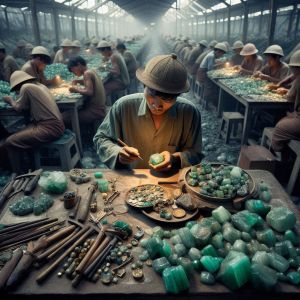Jade Trading
The 12-Million-Euro Jade: Dystopian Glimmer of Exploitation and Laundering
Today we are talking about jade—shiny, smooth, mysterious. A stone once revered by emperors, now being hustled on international auction floors for over 12 million euros. The price tag screams "rare", "precious" and "historically significant" but what does it whisper if you lean in close? Probably something like, “I’m just a rock, and you've been played.” Or worse: "I’m your friendly neighborhood money laundering tool."
You see, the world of jade trading isn't quite the romantic saga of mystical stones and sacred energy that you might expect. It's more of a dystopian underworld of exploitation, military funding, and smuggling networks. Let's crack open this shiny façade and take a peek at the messy, exploitative gears that make the jade trade tick.
From Myanmar Mines to Thai Auction Houses
First, let’s talk about how these “rocks” even make their way into the global market. The biggest producer of jade? Myanmar. A country not exactly known for its peaceful politics or glowing human rights record. The jade mined here isn’t just dug out of the earth—it’s practically pried from the backs of exploited workers. These are often men, women, and even children forced into labor by militias, mining syndicates, or the military junta that has a stranglehold on the nation.[1] The conditions? Hazardous. The pay? Pennies, if that.
From Myanmar, the jade then makes its clandestine journey into Thailand, smuggled through jungles and across borders like some kind of rock-star fugitive. Once it lands in Thailand, it finds its way into the hands of wealthy buyers, jewelers, and art collectors, or worse, shady traders who have much more than just the aesthetics of a shiny green stone on their minds.
Is Jade Really That Valuable, or Is It Just a Fancy PnD?
Let’s get something straight: jade is valuable because we say it is. It’s a rock, like many other rocks, but it has been imbued with centuries of myth and culture. In reality, it’s susceptible to all the same physical damage that a common stone is—drop it from a height, and boom, it shatters. Sure, it has a cultural significance and looks beautiful when polished, but let’s face it: jade's absurd price tags don’t match up with the stone’s intrinsic worth.
Sound familiar? Yeah, jade is starting to look like the cryptocurrency of the ancient world—a value system built entirely on perception. Just like in a Pump-and-Dump (PnD) scheme, the value of jade is often inflated by powerful traders and syndicates. What keeps that price soaring? In many cases, wash trading. A technique where parties artificially raise the price of jade through a series of fake sales, bouncing the stones between shadowy buyers and sellers who may not even exist. It’s like cryptocurrency, but older and with a little more polish (literally).
Money Laundering on the Rocks?
But wait, it gets better—or worse, depending on your level of dystopian cynicism. Jade trading isn’t just about the stones themselves; it's a convenient vehicle for money laundering. Think about it: who’s going to question a 12-million-euro jade sale in a luxury auction house? The source of the money, the buyer’s legitimacy, and even the seller’s identity are often as opaque as the jade itself. In many cases, the jade trade is just a shiny front for moving dirty money from one set of hands to another—hands that could belong to drug cartels, corrupt military officials, or even terrorist organizations.
In fact, the ruling military dictatorship in Myanmar is suspected of using jade sales to fund its operations[2]. The workers at the mines? They may just be pawns in a much larger, darker game, their labor contributing to the very forces that oppress them. Imagine that: the jade you admire in a posh boutique might be financing a brutal regime’s grip on power.
Fake Jade at Bargain Prices—Why Not?
Now, if you’re thinking, “Maybe I’ll just get a cheap jade piece from a street vendor in Bangkok instead,” think again. The market is also flooded with fake jade—cheap knock-offs passed off as the real thing to unsuspecting tourists and collectors. These fakes can range from dyed stones to plastic imitations. At this point, jade becomes not just a symbol of luxury but a symbol of deceit. You’re either getting scammed by overpriced legit stones or buying fakes, thinking you’ve scored a deal. Either way, you’re likely being hustled.
Jade: The Green Stone of Greed
In the end, jade’s journey from the blood-stained mines of Myanmar to the polished shelves of luxury stores is a dystopian tale of greed, exploitation, and deception. It’s a commodity that is as much a tool of power and corruption as it is a fashion statement. So, the next time you hear about a jade stone selling for millions, remember: it's not just a rock, but a shining symbol of everything wrong with a world where value is manufactured, wealth is hidden, and human lives are cheap.
And if you’re thinking about investing in jade, just ask yourself—do you really want to be part of this shady game, or would you rather keep your money in something a little more transparent? Like, I don't know, dogecoin?
In the end, whether it’s a rock or a coin, the game remains the same: the price isn’t real, and the people at the bottom? They’re just as invisible as ever.
China and Relationship with Jade
Jade and China: A Historical Obsession Meets Modern Exploitation
Jade isn't just a shiny green rock for China—it’s a symbol of power, status, and spirituality woven deep into the nation’s cultural fabric. Historically, jade was revered by emperors, used in religious rituals, and even considered to have life-giving properties in Chinese philosophy. If you had jade in ancient China, you weren’t just rich—you were practically a god. But fast forward to modern times, and China’s own jade reserves have been mostly mined to dust. So, what do you do when your precious commodity runs dry? You look elsewhere—particularly to a neighbor with an abundance of this mystical stone.
Enter Myanmar, the land of jade riches, where the green treasure is found in abundance. Once China realized that its local supply was depleting, Myanmar became the next logical source. But, as is typical in a world driven by profits and geopolitics, this wasn’t just some friendly trade agreement. It was more like an economic extraction machine, powered by exploitation and smuggling networks.
Why Myanmar? The Perfect (Exploited) Neighbor
Why Myanmar? Well, for starters, it has jade—lots of it. But there’s more to it than just that. Myanmar is a country with weak governance, a powerful military junta, and porous borders. In short, it’s the kind of place where shady business dealings can thrive without much oversight. So while Myanmar digs its jade out of dangerous mines through exploited labor, China—like the eager investor in the background—waits with open arms. It’s a convenient arrangement.
Now, you might wonder, why not just export the jade directly from Myanmar to China? Why go through Thailand? Because Thailand is like the friendly, business-savvy middleman in this equation. Thailand’s comparatively stable political situation, ease of doing business, and, let’s be honest, its relaxed attitude towards shady enterprises like illegal online gambling, call center scams, and money laundering make it the ideal hub for jade trading. Thai law enforcement isn’t exactly breathing down the necks of everyone importing and exporting goods, especially if those goods happen to be the bread and butter of a shadow economy.
Post-COVID: Demand for Shiny Rocks Takes a Dip
But here’s the kicker—post-COVID, the demand for jade hasn’t exactly bounced back. Turns out, when people are strapped for cash and more focused on survival than on flaunting status symbols, they’re less likely to blow their savings on jade bangles and necklaces. Shocking, right? The luxury market, especially when it comes to accessories, has taken a hit. People are more concerned with essentials than with ancient symbols of wealth. And let's face it: shiny rocks don’t pay bills.
In fact, even China, which was historically the world’s biggest market for jade, has seen a slowdown in consumer interest. Sure, the ultra-rich might still be trading and collecting jade as an investment, but your average middle-class shopper? Not so much. People are starting to wake up to the fact that jade isn’t the mystical financial hedge it once was—especially when there are more pressing concerns like, you know, food and housing.
So, You Want to Get Into Jade Trading? Don’t.
Now, let’s say you’re tempted to dive into the jade market, thinking it’s a savvy investment. Maybe you’ve heard about that 12-million-euro jade sale and thought, "I want a piece of that action!" Let me stop you right there. First of all, unless you have the connections of a smuggling ring, a military junta on speed dial, or the negotiating skills of a black-market jeweler, getting into jade trading isn’t going to be the smooth business deal you think it is.
But more importantly, ethically speaking, supporting the jade trade as it stands today is about as responsible as investing in blood diamonds. The jade from Myanmar is mined under terrible conditions, with exploited workers and profits likely going to fund a military dictatorship. The concept of humanely sourced jade? It's about as real as a unicorn in this market. Sure, you might hear talk of corporate responsibility and ethical sourcing, but in a world of late-stage capitalism, where profit margins rule above all else, don’t hold your breath.
Alternatives? Gold – The Shiny Rock You Can't Shove Up Your Butt (Easily), Cryptocurrencies—Anything But Jade
If you’re looking for something to invest in that won’t haunt your conscience, maybe try gold. At least gold is well-regulated, has a stable historical value, highly malleable and doesn’t involve as much shady dealings (well, most of the time). Better yet, if you have a higher tolerance for volatility and enjoy taking on more speculative risks, why not go the cryptocurrency route? At least with crypto, you know exactly what kind of unregulated, chaotic market you’re getting into—and unlike jade, you won’t need a team of miners risking their lives to make it happen.
The jade market, in contrast, is a murky mess of exploitation, political corruption, and declining demand. So, if you care about where your money goes—or if you just want to sleep at night knowing you’re not funding a brutal military regime—it’s best to steer clear of jade. You might just be better off with your crypto wallet, riding the waves of Bitcoin or Ethereum, because at least in that dystopian world, the only one being exploited is you; the retail traders.


